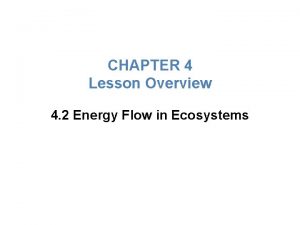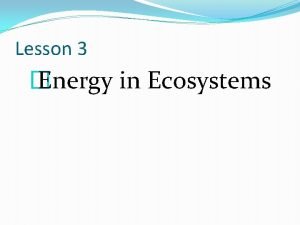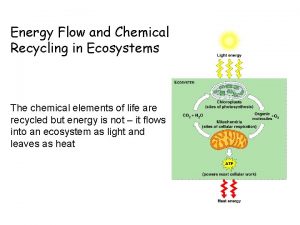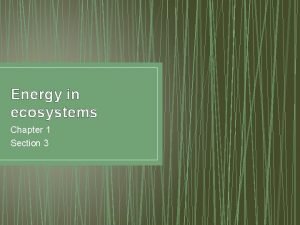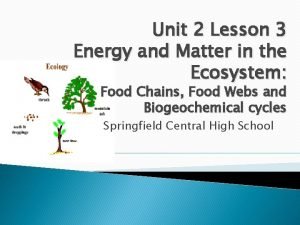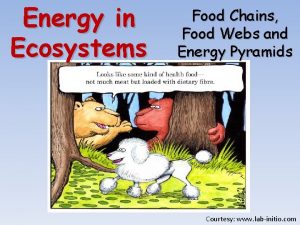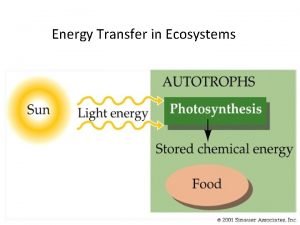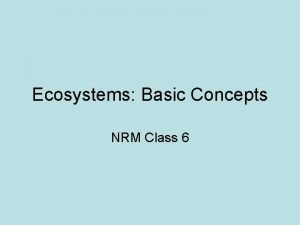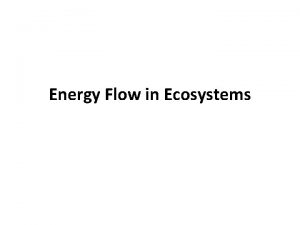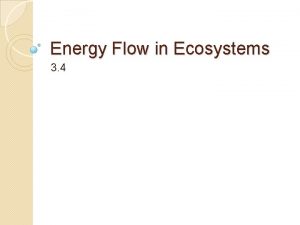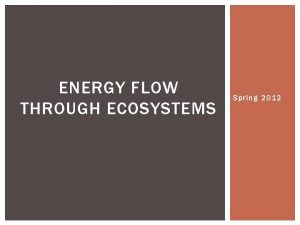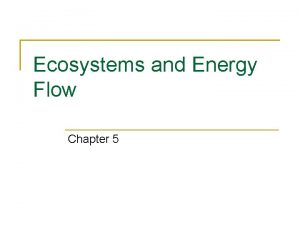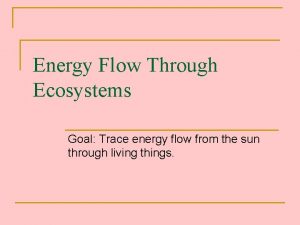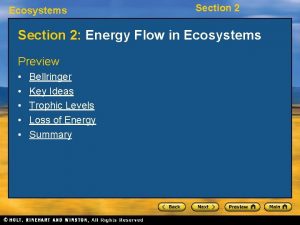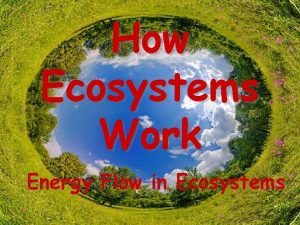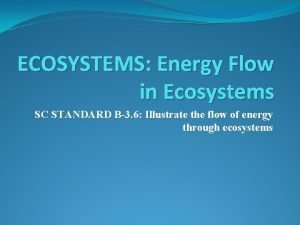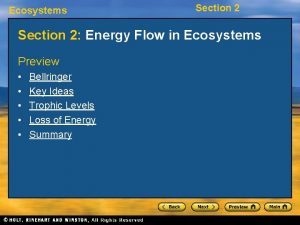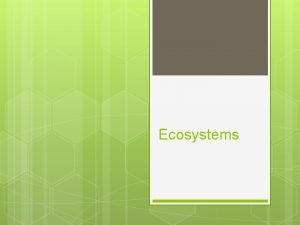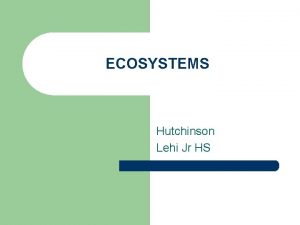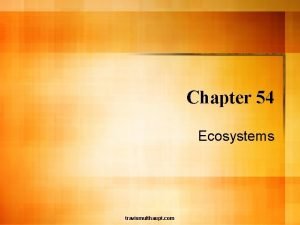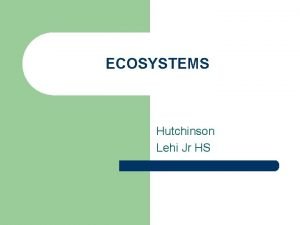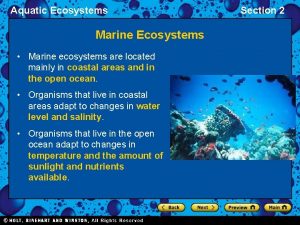August 22 2017 Energy Flow in Ecosystems WarmUp

































- Slides: 33

August 22, 2017 Energy Flow in Ecosystems Warm-Up: Think of the word “producer. ” Write down what you think it means. What about consumer? Agenda: 1. Warm-Up 2. Energy Roles 3. It’s your Niche! 4. Measure Chia Pets

Energy Roles An organism’s energy role is determined by how it obtains energy and how it interacts with other organisms. Each of the organisms in an ecosystem fills the energy role of producer, consumer, or decomposer.

Niche A niche is the role or “job” of an organism or species in its environment. What would be a bee’s niche?

Producers Energy enters most ecosystems as sunlight. Some organisms, such as plants, algae, and some bacteria, capture the energy of sunlight and store it as food energy. (Through photosynthesis) An organism that can make its own food is a producer. Energy is transferred to

Consumers Some members of an ecosystem cannot make their own food. An organism that obtains energy by feeding on other organisms is a consumer.

Consumers are classified (grouped) by what they eat. Herbivores Carnivores Omnivores Scavengers

Consumers - Herbivores Consumers that eat only plants are herbivores. Examples: caterpillars and deer


Consumers - Carnivores Consumers that eat only animals are carnivores. Examples: Lions and spiders


Consumers - Omnivores Consumers that eat both plants and animals are omnivores. Crows, bears, and most humans are omnivores.


Consumers - Scavengers Some carnivores are scavengers. A scavenger is a carnivore that feeds on the bodies of dead organisms. Examples: catfish and vultures http: //www. fisheriesmanagement. co. uk/catfish_introduction. htm

Decomposers break down wastes and dead organisms and return the raw materials to the ecosystem. You can think of decomposers as nature’s recyclers. Mushrooms and bacteria are common decomposers.

Important Questions Give an example of a producer. Give an example of a consumer. What are the 4 kinds of consumers? Give an example of a decomposer. What do food chains show? What does a food chain always begin with? What’s the difference between a food chain and a food web? What does an energy pyramid show? Summary Energy Flow In Ecosystems

It’s your Niche! Choose any organism you would like. Identify that organism’s niche! Design a business card for your organism and it’s niche. Your card MUST include: *Name of organism *Company Name *Job Title *Address and Phone Number *Slogan *Illustration

August 24, 2017 Energy Flow in Ecosystems Warm-Up: What is a habitat? How does a habitat meet the needs of organisms? Agenda: 1. Warm-Up 2. Measure Chia Pets 3. Journal Article 4. Food Webs and Energy Flow

Measure Chia Pets DATE 8/15/17 Group A ---Control (Ms. Thomas) Group B ---- Extra Light (Kaylor) Qualitative Quantitative

Journal Article Must write the full required amount to get credit. The article must be about the assigned topic. The article you find must be newer than 2013.

Food Chains and Food Webs Energy enters most ecosystems as sunlight and is converted into food molecules by producers. This energy is transferred to each organism that eats a producer, and then to other organisms that feed on these consumers. The movement of energy through an ecosystem can be shown in diagrams called food chains and food webs.

Food Chains Every living thing needs energy in order to live. Every time animals do something (run, jump) they use energy to do so. Energy is necessary for living beings to live and grow. Animals get energy from the food they eat, and all living things get energy from food. Plants use sunlight, water and nutrients to get energy (photosynthesis).

Food Chains A food chain shows how each living thing gets food, and how nutrients and energy are passed from creature to creature. Food chains begin with plant-life, and end with animal-life. Some animals eat plants, some animals eat other animals. http: //www. sheppardsoftware. com/content/animals/kidscorner/foodchain/decomposers. htm

There is actually even more to this chain. After a hawk dies, fungi (like mushrooms) and other decomposers break down the dead hawk, and turn the remains of the hawk into nutrients, which are released into the soil. The nutrients (plus sun and water) then cause the grass to grow. It's a full circle of life and energy!!

ON THE BACK OF YOUR PAPER: Draw your own food chain with FOUR organisms.

A food web consists of the many overlapping food chains in an ecosystem. A food web is more realistic accurate than a food chain. Food Webs

Which is more stable? A food web is more stable than a food chain.

A Typical Food Web Comprised of several food chains

Energy Pyramids An energy pyramid shows the amount of energy that moves from one feeding level to another in a food web. Where is the most energy available? Why does less energy become available at each level?

How the numbers work in an Energy Pyramid Only 10% of the available energy moves to the next trophic level. ***Most of the energy is lost as heat.

Complete the Food Webs Activity Sheet! You may work with a partner.

WARM UP 8/18/2016 1. Take out your scissors, colored pencils, and glue! 2. Discuss food webs with your neighbor. What do you remember about yesterday’s discussion?

Food Web Diagramming 1. Color according to key: Producers(autotrophs) GREEN Herbivores (primary consumers) BLUE Omnivores and carnivores (secondary consumers) RED Carnivores (tertiary consumers) PURPLE Scavengers ORANGE Decomposers BROWN Energy Source YELLOW 2. Use scissors to cut pictures out. 3. Sort pictures according to energy roles 4. Construct a food web using 12 of the cutouts.

Try These… 1. Pick an ecosystem (any one you want), and list as many abiotic and biotic factors as you can. 2. Draw a food web within that ecosystem that includes at least four trophic levels and six different organisms. Label the levels and energy roles of each organism. 3. If there is 10, 000 kcal of energy available at the producer level, how many kcal would be available to an apex predator? 4. Remove one organism from your food web and explain the effect that this would have on the rest of the organisms.
 Chapter 4 lesson 2 energy flow in ecosystems
Chapter 4 lesson 2 energy flow in ecosystems Which marine ecosystem contains the fewest producers
Which marine ecosystem contains the fewest producers Motive force
Motive force Primary consumers
Primary consumers Section 1 energy flow in ecosystems
Section 1 energy flow in ecosystems 1260 days to years
1260 days to years Warmup ratio
Warmup ratio Warmup 65
Warmup 65 Gmass warmup
Gmass warmup Status vs class
Status vs class Pyramid warmup
Pyramid warmup Pop thats their warmup
Pop thats their warmup Multiplying exponents with same base
Multiplying exponents with same base Java warmup
Java warmup Define:warmup
Define:warmup Pathos story
Pathos story Tinman warmup
Tinman warmup 65 mins
65 mins Warmup end
Warmup end Flow energy review
Flow energy review Flow of energy vs flow of matter
Flow of energy vs flow of matter Section 3 energy in ecosystems
Section 3 energy in ecosystems Chapter 42 ecosystems and energy
Chapter 42 ecosystems and energy Nutrient chain foldable
Nutrient chain foldable Phosphorus cycle
Phosphorus cycle Lab food chains and energy in ecosystems
Lab food chains and energy in ecosystems Do birds eat squirrels
Do birds eat squirrels Ecosystem energy transfer
Ecosystem energy transfer Food chain for class 6
Food chain for class 6 Energy energy transfer and general energy analysis
Energy energy transfer and general energy analysis Energy energy transfer and general energy analysis
Energy energy transfer and general energy analysis Magic box respiratory
Magic box respiratory Venturi mask vs face mask
Venturi mask vs face mask T piece ventilation
T piece ventilation
